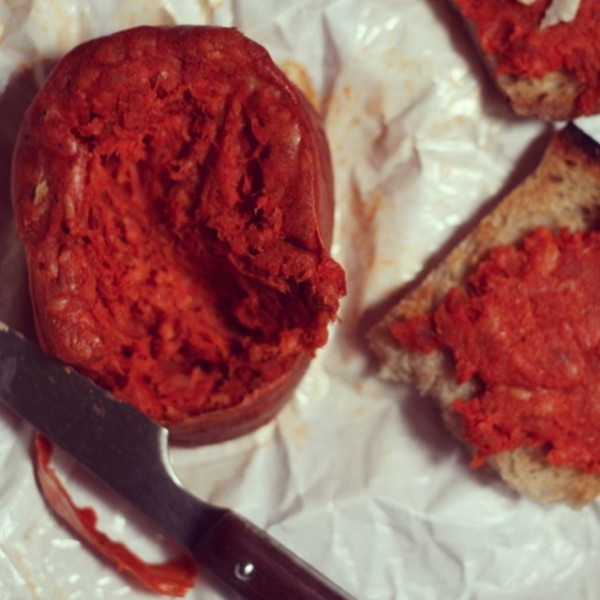spain's great meats : sobrassada edition
I often ask myself why sobrassada isn't one hundred (or 1,000) times more popular. I mean, if you are reading this, and you're not Spanish, do you know what sobrassada is? My point exactly.
I think one reason could be the linguistic resemblance to the Italian meat that has already made its name abroad. But soppressata is really just another form of salami. And I hate to sound jaded here, but one type of salami is plenty for me. Sobrassada, on the other hand, is the Mallorcan lovechild of chorizo and pate. This creamy, flavorful cured meat dates back to the 16th century, on the Spanish island of Mallorca, and the use of sweet Spanish paprika, one of its distinguishing characteristics, dates back to the 18th century.
Let's cut to the chase: this is perhaps one of the greatest meaty things happening in all of Spain. Right up there with jamón ibérico and morcilla. What is it exactly? It's a mix of lean pork meat and bacon, with a healthy helping of paprika, salt, and some other spices, which can include pepper, rosemary, thyme and oregano. The bright red color comes from paprika, as adding artificial color is strictly forbidden. The whole thing is packed into either a real or artificial (collagen) casing and cured for a few weeks (depending on size).
While this sounds like chorizo...it's not. The resulting cured meat is creamy, more like a pate, due to the high fat content. You spread it on bread, or spoon it into your mouth, or use it in recipes, like the croquetas at the Boqueria's Bar Pinotxo.
I brought some back from Barcelona because I am absolutely addicted/enamored/obsessed with the stuff. If you are in the market, you should know there are a few different formats:
- longaniza: a long, sausage shape, usually 200-300 grams.
- rizada:the most common format, usually under a kilogram.
- semirazada: similar to rizada but smaller
- culana: big, long versions that are around 2-3 kilos.
- bufeta: a round, loaf looking format, tied with three strings and usually under 1.5 kilos.
- poltrú: looks like rizada, but bigger
- bisbe: the biggest version, ranging from 4kg to 30kg.
The formats variation is due to the fact that they are packed in different animal organ casings, from intestine to bladder. Yum! As illustrated in this lovely pic from masmallorca.com.



